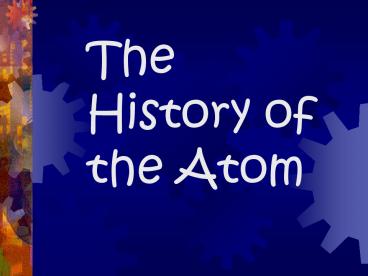The History of the Atom - PowerPoint PPT Presentation
1 / 22
Title:
The History of the Atom
Description:
Democritus concluded that matter could not be divided into smaller and smaller pieces forever. ... this thought with Democritus hypothesized that atoms were ... – PowerPoint PPT presentation
Number of Views:214
Avg rating:3.0/5.0
Title: The History of the Atom
1
The History of the Atom
2
Aristotle
- Aristotle was the first scientist that we have
record of questioning what stuff was made of. - What did he think?
3
The search for finding out about matter began
with the Greek philosopher Democritus more than
2000 years ago.
4
THE QUESTION
Could matter be divided into smaller and smaller
pieces forever, or was there a limit to the
number of times a piece of matter could be
divided?
5
The Answer
Democritus concluded that matter could not be
divided into smaller and smaller pieces forever.
Eventually the smallest piece would be obtained
that could not be divided. This piece is called
the atom coming from the Greek word atomos
which means not to be cut, or indivisible.
6
The hypothesis
The people that shared this thought with
Democritus hypothesized that atoms were all
small, hard particles that were all made of the
same material, but were of different sizes and
shapes.
7
Is that hypothesis correct?
8
In 1803, John Dalton from England combined his
and other observations to propose the atomic
theory.
9
The Atomic Theory
All elements are composed of atoms. Atoms are
indivisible and indestructible particles. Atoms
of the same element are exactly the
alike. Atoms of different elements are
different. Compounds are formed by joining
atoms of 2 or more elements.
10
John Daltons model
- Billiard Ball Model
11
atoms are neither created or destroyed in a
chemical reaction
12
Law of conservation of Mass
13
Laws of Proportions
- Definite water is always 21
- Multiple rearrange and the same elements in a
22 ration a new substance!!
14
The Ancestor of the TV Tube.
At the end of the 19th century cathode rays were
being experimented with. These are produced in
glass tubes under a vacuum and the tube it is in
is called a cathode ray tube (CRT). In 1897 J.J.
Thompson observed that the cathode rays are made
up of very small, negatively charged particles
that are a fundamental part of an atom.
What did J.J. Thompson just discover?
15
Thompson discovered the electron. He knew that
something had to be in the atom to balance the
negative charge, but was unable to find it. With
his information he created a new model of the
atom and called it the plum pudding model.
16
Millican
- Discovered the MASS of the electron to be 1/2000
(1/1837) of a Hydrogen atom. - All atoms have electrons (acted the same in the
cathode ray) - 2 inferences made from here
- Since atoms are electrically neutral-ther are
s of protons and electrons - Since electrons mass is so small, most atoms
mass must be in the neucleus.
17
The Next New Find
18
In 1908 Ernest Rutherford fired a stream of
positively charged particles at gold foil and
found that most of them passed right through
while others hit something and bounced away.
What would cause something to repel a positive
charge?
Another positive charge.
19
From his information, Rutherford proposed that an
atom had a small, dense, positively charged
center that he named the nucleus.
The Rutherford Model
20
In 1913 an improvement to the Rutherford model
was made by Niels Bohr. According to this model,
the electrons move in definite orbits around the
nucleus, much like planets in the solar system.
These orbits, or energy levels, are located at
certain distances from the nucleus.
21
Niels Bohr
22
The current atomic model has electrons in a
probable location based on how much energy the
electron has. An electron cloud is the space in
which the electrons are likely to be found. This
cloud is broken into energy levels. Electrons
with lower energy levels are found close to the
nucleus.































